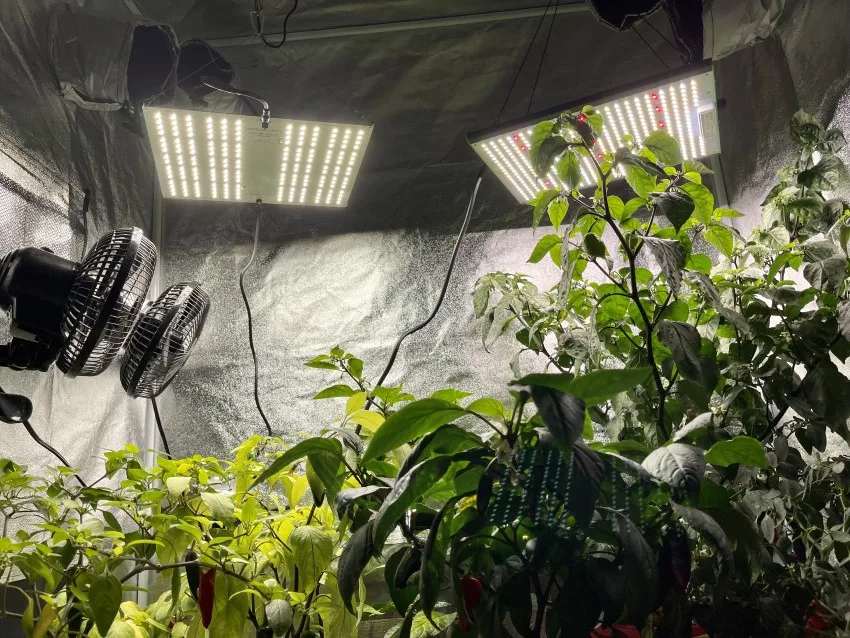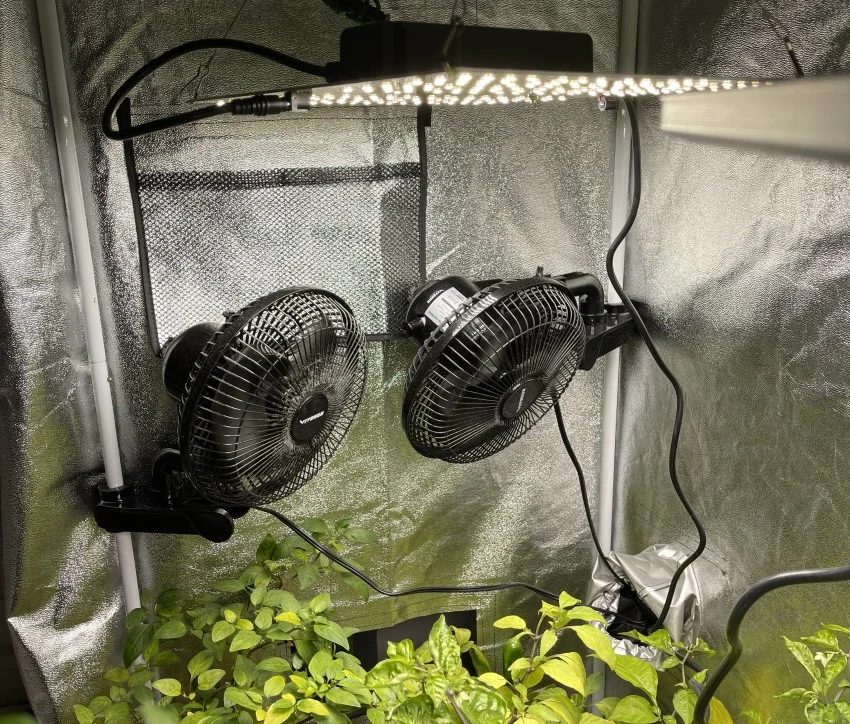Grow tents and rooms facilitate indoor plant cultivation, enabling plant lovers to create highly efficient garden ecosystems in their homes. The main benefit of having a grow tent is that you can easily maximize your yields by monitoring a few key variables, one of the most important ones being humidity. Maintaining an optimal humidity level in your grow tent will support your plants’ growth while extending their lives.
So here are a few ways in which you can raise the humidity in a grow tent:
- Use a humidity controller in your grow tent.
- Put containers of water by air holes, grow lights, or fans
- Place propagators in your grow tent.
- Use a spray bottle to mist your plants regularly.
- Grow plants of different ages in the same tent.
- Reduce your tent fan speed to a minimum.
- Use a humidifier (or several) in your grow tent.
- Place wet sponges near any air holes, grow lights, or fans.
- Lower the temperature by reducing fluorescent tubes.
Some of these tips are universal in that they apply to all grow tents, while others will work with certain types of grow tents. Keep in mind that the size of your grow tent is crucial when selecting a humidity-maximizing strategy. Keep reading to learn more about the most effective ways to control the humidity in a grow tent.
As an Amazon Associate, I earn from qualifying purchases.

1. Use a Humidity Controller in Your Grow Tent
A humidity controller will help you determine whether it is humid enough to suit your specific plants. When growing plants in a grow tent, it is not enough to simply get a humidifier or place bowls of water here and there to create a more hospitable ecosystem.
Saying that plants thrive in humid environments is a generalization: depending on where they are in their lifecycle, plants require specific humidity levels, so it is essential that you know how humid your grow tent is and how humid you want it to be.
Even the most experienced gardener cannot estimate the humidity level in their grow tent without adequate tools, hence the importance of using a humidity controller. The table below should give you a rough idea of the different humidity levels plants require:
| Plant’s stage | Level of humidity required | Why |
| Seedlings | Around 70 – 80 percent | Young plants need more moisture to grow their roots. |
| Vegging | Between 50 and 60 percent | Vegging plants need quite a bit of moisture to keep growing, even though they have already developed roots. An arid environment would slow their growth. |
| Flowering | Between 40 and 50 percent | A higher level of humidity may lead to the formation of mold and mildew. |
2. Put Containers of Water by Air Vents, Lightbulbs, or Fans
If you do not want to purchase a humidifier, this method might work for you. By placing a bowl or pot full of water near an air vent, fan, or lightbulb, you will exploit the power of evaporation to raise the humidity level in your grow tent.
A medium-sized bowl or pot should do if your grow tent is small. If your grow tent is larger, you may want to use at least two bowls or pots to add extra moisture to the air. Always keep in mind that if your plants are still in the process of growing roots, you will need more humidity.
3. Place Propagators in Your Grow Tent
This method is ideal for seedlings. While plants can grow their roots without external help, propagators will allow you to keep your seeds moist and protected, thus optimizing germination.
This EarlyGrow Medium Seed Propagator from Amazon.com, for instance, can reach a humidity level of approximately 80 percent, which makes it perfect for baby plants. Several propagators in a larger grow tent will offer the benefit of increasing the humidity of other plants in the seedling’s vicinity.
4. Use a Spray Bottle to Mist Your Plants Regularly
Misting your plants with a spray bottle is the most time-consuming way to raise the humidity in your grow tent. This method, however, is undoubtedly effective. Just use a humidity controller to monitor the humidity level in your grow tent and mist your plants accordingly. This method is more suited for smaller grow tents.
5. Grow Plants of Different Ages in the Same Tent
Contrary to what some say, larger / older plants do not steal nutrients from younger / smaller plants. On the contrary, because larger / older plants have a higher transpiration rate, they release more moisture into the air, thus supporting the growth of smaller plants.

6. Reduce Your Tent Fan Speed to Minimum
Proper ventilation is essential to create an ecosystem where plants can grow and thrive. Grow tents come with air holes or vents so that the air inside them gets replaced continuously.
Some grow tents also come with one or more fans to ensure optimal air circulation – sometimes, gardeners install them for best results. If your tent has one or more fans, set their speed to a minimum to prevent them from creating an overly dry environment.
If your tent holds multiple fans, consider removing some of them to achieve a higher relative humidity level.
If you are looking for some good grow tent fans I recommend Growbuds 6 Inch Oscillating Clip-on fan found at Amazon.com.
7. Use a Humidifier (or Several) in Your Grow Tent
A humidifier is the most effective way to raise the humidity in a grow tent. While more expensive than a spray bottle and a bowl full of water, a humidifier will allow you to achieve and maintain the optimal humidity level for your plants quickly and easily.
You can choose from many humidifiers, some being more powerful (and expensive) than others. A relatively basic humidifier will undoubtedly do if your tent is relatively small. An excellent choice is the VIVOSUN Air Humidifier 4L Cool Mist Humidifier (available on Amazon.com). This dehumidifier is a compact and highly efficient humidifier and is highly portable with an easy-to-carry handle.
You may use multiple less-powerful humidifiers for bigger tents or switch to more powerful models such as the LEVOIT Large Room Humidifier (available on Amazon.com). The Levoit’s large tank offers 60 hours of continuous operation, and the machine has an inbuilt humidity adjuster to maintain a constant humidity level.
8. Place Wet Sponges Near Any Air Vents, Lightbulbs, or Fans
Back to another inexpensive yet somewhat effective method to raise the humidity in a grow tent. By placing some wet sponges on the floor or near any air vents, lightbulbs, or fans in your grow tent, you will exploit the power of evaporation to create extra moisture.
Because wet sponges tend to dry out rather quickly, you will have to replace your sponges regularly to maintain an optimal humidity level in your grow tent.
9. Lower the Temperature by Reducing Fluorescent Tubes
If your grow tent is equipped with multiple fluorescent tubes, try removing one or two and check after a while to see if the humidity level has gone up (you will need a humidity controller for this).
Fluorescent lights get rather hot, raising the temperature in your grow tent and making the air drier. The corresponding heat reduces the moisture content of your tent’s interior air and thus reduces the humidity levels.
You should consider your plants’ light requirements. Some species, such as orchids and gardenias, require high amounts of light to thrive. If your plants are still very young, they will probably not need too much light.
Key Takeaways
There are many ways to raise a tent’s humidity level, but we suggest starting with the more cost-effective methods to see if they work for you. You could try some basic tricks in this article, such as these easy methods:
- Use containers of water or wet sponges and place them strategically.
- Use spray water bottles for smaller tents.
- Reduce fan speed or the number of lights.
- Use an evaporative cooler.
One thing that you should invest in is a humidity controller to allow you to monitor the humidity level in your grow tent and boost your yields.
